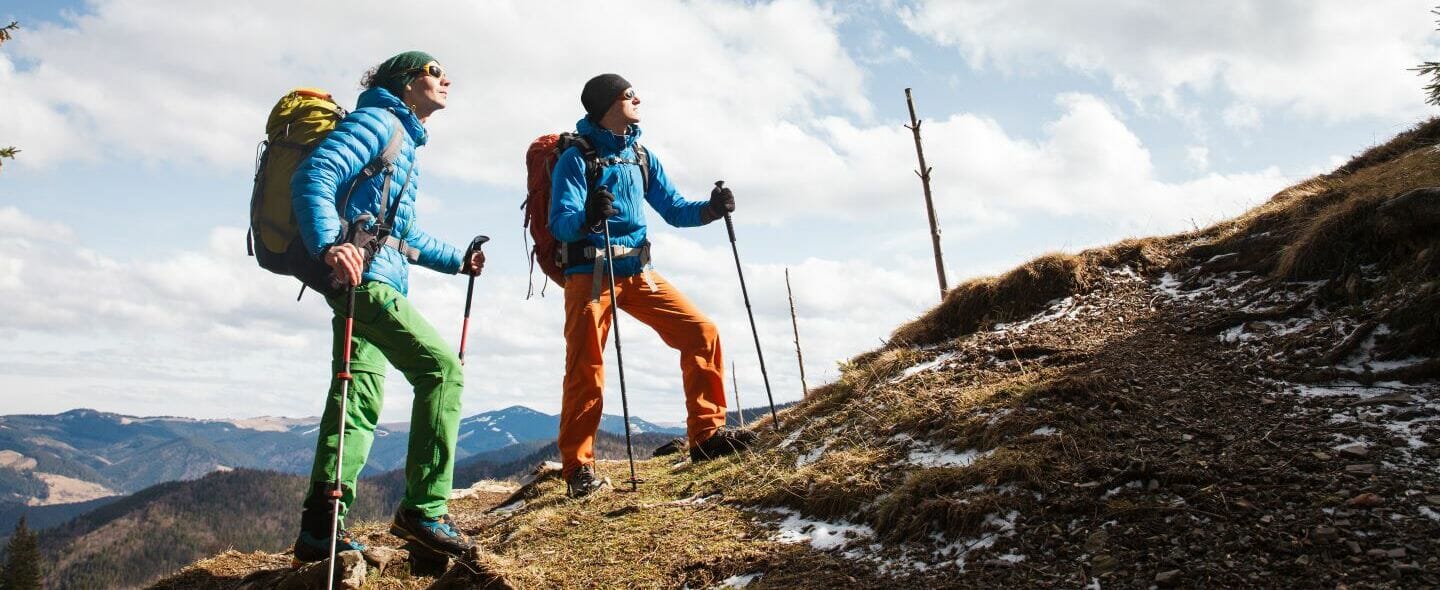Go up to the mountains, they said. It’s nice there, they said. But no one mentioned that it can also be quite exhausting. And certainly no one mentioned that it could have been significantly more pleasant with poles.
It is one of those “aha” moments that you experience every now and then when climbing mountains. At least that’s how I felt the first time I used walking poles. They offer better stability, physical relief and ultimately a much more pleasant mountain experience all round.
But as is so often the case, it is not simply a matter of picking up poles and getting started. There are a few technical tricks to consider which ensure that the whole thing actually works. We are certainly planning on explaining these to you, but firstly…
The pros and cons of walking poles – yes or no?
There are many advantages to using walking poles. As previously mentioned and among other things, there is the lower body joint and muscle relief, e.g. when walking downhill. This type of strain can amount to several tonnes depending on the duration of the tour. In addition, the poles provide the necessary stability, especially when crossing rivers or névé fields, or improve surefootedness and balance when traversing. Ultimately, the poles even help to optimise posture as they straighten the back leading to an overall “better” way of walking.
Nevertheless, what reasons could there be against the use of poles? There is, for example, the aspect that poles can quickly tilt in difficult terrain and thus cause problems. In rope-secured passages, in particular, poles can also be quite unhandy, and critics repeatedly note that excessive pole use inhibits training the sense of balance. Finally, of course poles are not immune to breaking, which is why you should never fully trust their material in dangerous situations.
The medical commission of the UIAA (Union Internationale des Associations d’Alpinisme) above all recommends poles in cases of:
- Old age
- Excess weight
- Joint or spine diseases
- Carrying heavy loads
Setting the correct length

Once you have chosen the right pair from the wide range of different walking poles, you are faced with the question: “How long should the poles actually be?” A simple basic rule helps here: they should be so high that the arm reaches an angle of 90 degrees when you hold the handle of the pole in your hands and the pole is standing vertically on the ground. You can lengthen the poles a little on steep descents and shorten them a bit on steep ascents. When adjusting, make sure that the locks are tightened firmly so that the poles do not collapse.
Pro-tip: at high altitudes or in particularly cold regions, the poles should be long enough to open the arm angle slightly so that the hands lie below the elbows which allows for a sufficient blood flow.
By the way, you can also easily figure out the optimal length using our length calculator for walking poles (we have separate calculators for ski poles, cross-country ski poles and Nordic walking poles).
The right grip
A popular mistake on the first tour with poles is the wrong grip, meaning that the loop is often simply threaded from above. Correctly, you should reach through the loop from below so that you can exert pressure on the pole even with an open or loose hand. This allows you to open your hands during backswing movements without having to give up on the relief. Furthermore, it prevents the hands from cramping up too much.
On a traverse, it can be helpful to grip the uphill facing pole by the hold extension – if applicable. The valley facing pole should be held like a pommel which allows for a better support. Besides, in case of doubt, it is recommended to not have your hands in the loop when doing a traverse, so that they are free in case of an emergency.
Using the walking poles correctly
To achieve the best possible effect, it is advisable to keep the poles close to the body at all times. In flat terrain, the poles are diagonal and are used alternately, according to the natural pattern of movement. In principle, this is the Nordic walking technique, only without the conscious use of force. Obviously, under these circumstances they are also most likely to be left out.

In steeper terrain, the double poling technique is the more sensible option. The poles are usually placed at every second step whilst pushing yourself up forcefully with both arms. This ensures stability and relief. Even downhill, the double poling technique constitutes the best choice. However, if possible, you should not poke, but grip the hold normally and, above all, pay attention to a clean technique so that you do not slip away, stumble and, in the worst case, fall.
Where do we go from here? Do I need poles or not?
So the answer to the question of whether you should always have walking poles with you is a resounding YES and NO.
They are always useful, but only if you know how to use them properly and take a few simple rules into account. If not they will either prove useless or even pose a hindrance. Perhaps a good recommendation could be to use the poles at times – especially on technically difficult tours – and to leave them at home at other times, seeing as without poles the sense of balance is trained and muscles are exercised more effectively.
What is your opinion? Yes or no to poles? We look forward to receiving your comments!






